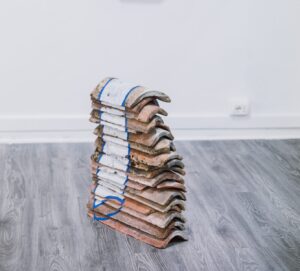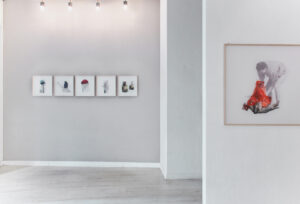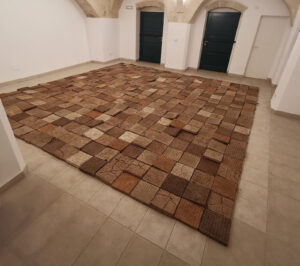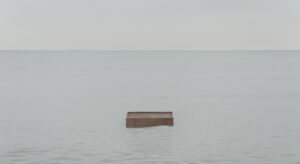In Bologna, the Lercaro Collection, in virtuous emulation of the similar project organized by the nearby MAMbo, offered its exhibition spaces to some young artists to use them as a studio and a platform for dialogue and meeting. Following a call for artists under 30 published last summer, Sofia Bersanelli (Milan, 1993), Alessandra Brown (UK, 1992), Matteo Messori (Reggio Emilia, 1993), Caterina Morigi (Ravenna, 1991) and Norberto Spina (Turin, 1995) were invited, each of whom was asked to design an original work on the theme “freedom and responsibility”. The five were joined by the DAMP Collective (Alessandro Armento, Luisa de Donato, Viviana Marchiò and Adriano Ponte) and Raffaele Vitto (Canosa di Puglia, 1993), called to create site-specific works respectively on the terrace and in the internal courtyard of the Lercaro Foundation. The project is coordinated and followed by Francesca Passerini, director of the Lercaro Collection, Andrea Dall’Asta, her predecessor in the direction, the critic, curator and teacher Claudio Musso and the young Laura Rositani, selected through a call dedicated to emerging critics. The aim of this residency is, in addition to offering the winners a temporary studio in which to work in view of the final exhibition, entitled Impronte (Footprints) and scheduled for spring (Covid restrictions permitting), to support them in the difficult passage from the Academy, which for some of them is a very recent experience, to a multifaceted professionalism like that of the artist through meetings with professionals from various fields, as well as with established artists such as Marzia Migliora and Francesca Pasquali. The peculiarity of this call is the fact that it has imagined a targeted path for very young people who, despite having already been followed by galleries, have won prizes and residencies or obtained commissions, have recently begun to face concrete production problems and all the issues related to definition of one’s own artistic identity and one’s own expressive languages.
One afternoon we went to visit their studios at the Lercaro Foundation and we met those who were there at that time to get some previews of the projects in progress. Competence in experimenting with materials, sensitivity in the re-elaboration of one’s own experience and attention to the construction of critical thinking are some of the characteristics that struck us in all the young artists, in addition to the sincerity with which they were willing to talk about themselves.
Matteo Messori‘s research is divided into two series: antiform and standing form, categories that suggest the complementarity of an empathic and physical-structural approach towards reality and its imaginative derivations. In his work, the tension between a gesture and a form always on the verge of exploding, the immersive vocation of his visions and the ability to capture the experience of space in a tribal expressive language whose vocation is to become a habitat, stand out. In the studio the artist showed us a pictorial and sculptural series focused on the visual and emotional restitution of a trip to Valle della Luna in Sardinia, where a community of hippies has lived permanently since the 1980s in a bay protected from building speculation thanks to generous donation. The energy of this extreme situation is the same that shapes the graphic or sculptural forms in which the memory of that violent landscape and its dramatic shadows acquires an iconic and primordial plasticity.
Alessandra Brown works on the semantic and formal relationships between images taken from everyday life which, detached from their original context, embody at the same time the lability of a memory destined to disappear and a strange subtle physicality that assimilates them to objects with weight and thickness. Her visual manipulations, ranging from photography to graphics and digital reworking, could be defined as interventions of “reality extraction” that materialize the gap of space between the image and its referent. The project that the artist is developing for the residency in Bologna involves the pictorial reworking of a series of screenshots of conversations that have taken place over the years through digital platforms. The shots freeze the moment when the image of one of the two interlocutors loses definition due to temporary slowdowns in the connection. Dwelling on interruption, Alessandra Brown investigates the concept of interface, relationship and time with elegant essentiality.
Norberto Spina roots his research in the marginal areas of the city where he lives, Milan, and in the social tensions that are perceived in the usury and vandalization of urban spaces. He experiences an initiation journey that starts from the exploration of the suburbs in which different cultures struggle to coexist and integrate and enters an idea of the road understood as an interpenetration of experiences. The artist recognizes the essence of humanity in the traces of extreme situations that the gray areas of the metropolis seem to hold back for longer and which for him become existential revelations. His project for Impronte starts from the photographic documentation of the chairs on which transsexual prostitutes wait for customers in parking lots or in secluded places. These objects, for him emblematic of the human factor that makes them interesting, are the subjects of a cross-hatched drawing that summarizes these situations in textures made with permanent marker that push to transform the density of an absence into painting.
Caterina Morigi‘s work investigates the relationship between micro and macro of matter by exploring intriguing hypotheses of intersection between man and nature that find their ideal matrix of reference in the ancient concept of mimesis. Her works are traps in which the two identity categories interpenetrate thanks to the meticulous detection of analogies (both in terms of structure and surface) which, emphasized by her interventions of superimposition, juxtaposition and imitation, become surprising. At the Lercaro Foundation, the artist experiments with a new painting process on paper made with different types of industrial disinfectant. The chemical reactions of these antiseptic substances, whose function is to inhibit the development of infectious microorganisms, generate unstable forms that paradoxically refer to organic suggestions. As in many other works by Caterina Morigi, this series also submits to the observer an enigma, in whose solution the deceptiveness of human sensory perceptions is evident.
Raffaele Vitto bases his language on the difficult reconciliation between the two contrasting souls that today mark his identity: being a young artist fully immersed in the flow of contemporaneity and an ancestral family tradition that binds him to the countryside and its rhythms. From his estate in Puglia the artist draws all the material, understood in a physical, symbolic and conceptual sense, that he uses to create his works, always oriented to be ephemeral and site-specific. The ambiguous relationship with his particular cultural background leads him to “work artistically like a farmer” to reflect concretely on the possibilities of integration between such different universes. For the internal courtyard of the Lercaro Foundation, Raffaele Vitto is designing an installation based on earth and flour that connects the layered iconography of bread with reflections on the aporias that govern the production and distribution of primary subsistence goods in a globalized society.
Regarding the projects of the artists that we were unable to meet, curator Laura Rositani tells us: “Sofia Bersanelli‘s multimedia practice makes use of different languages ranging from writing to drawing, from photography to video, to address issues such as the unconscious and memory, the precariousness and fragility of existence. Verbal expression, understood as word and sound, is of fundamental importance in the artist’s research and this study is the basis of the project that she is developing for the Impronte residency. Writing represents the starting point for a broader investigation into the relationship of encounter and dialogue between word and image, image and sound, visual language and verbal language. The DAMP collective, whose practice develops in close dialogue with the places the group relates to and with actions in natural and urban contexts, is developing a site-specific installation in the terrace space of the Lercaro Collection. For the Impronte project the artists are thinking of an action starting from the geometries of the flooring grid, which becomes a hypothetical and potential space that arouses reflections on the theme of residence, on the concept of freedom but also of limits “.
Info:
www.fondazionelercaro.it/impronte
 Sofia Bersanelli, “Spiraea”, video, color, 8’49, 2017
Sofia Bersanelli, “Spiraea”, video, color, 8’49, 2017
 Matteo Messori, “Antiforma”, acrylic, plaster, gypsum and vinavil on medical gauze. 400 x 200 cm, 2020
Matteo Messori, “Antiforma”, acrylic, plaster, gypsum and vinavil on medical gauze. 400 x 200 cm, 2020
 Alessandra Brown, “Hostages”, Curva Pura, Roma 2020
Alessandra Brown, “Hostages”, Curva Pura, Roma 2020
 Norberto Spina, “Da qualche parte esiste una fine”, car collectors, carob and acrylic paint, 2020
Norberto Spina, “Da qualche parte esiste una fine”, car collectors, carob and acrylic paint, 2020
 Caterina Morigi, ”1:1”, Bologna 2018, installation view at Museo MAMbo
Caterina Morigi, ”1:1”, Bologna 2018, installation view at Museo MAMbo
 Raffaele Vitto, “400 passi di terra”, earth and straw, 25 mq, 2019
Raffaele Vitto, “400 passi di terra”, earth and straw, 25 mq, 2019
 DAMP, “Apolide”, 2020
DAMP, “Apolide”, 2020
Graduated in art history at DAMS in Bologna, city where she continued to live and work, she specialized in Siena with Enrico Crispolti. Curious and attentive to the becoming of the contemporary, she believes in the power of art to make life more interesting and she loves to explore its latest trends through dialogue with artists, curators and gallery owners. She considers writing a form of reasoning and analysis that reconstructs the connection between the artist’s creative path and the surrounding context.






NO COMMENT